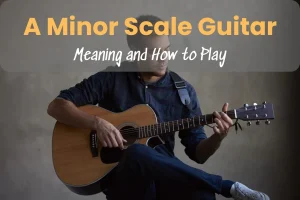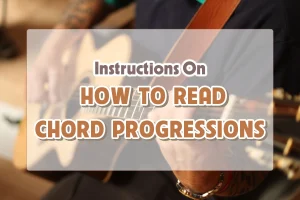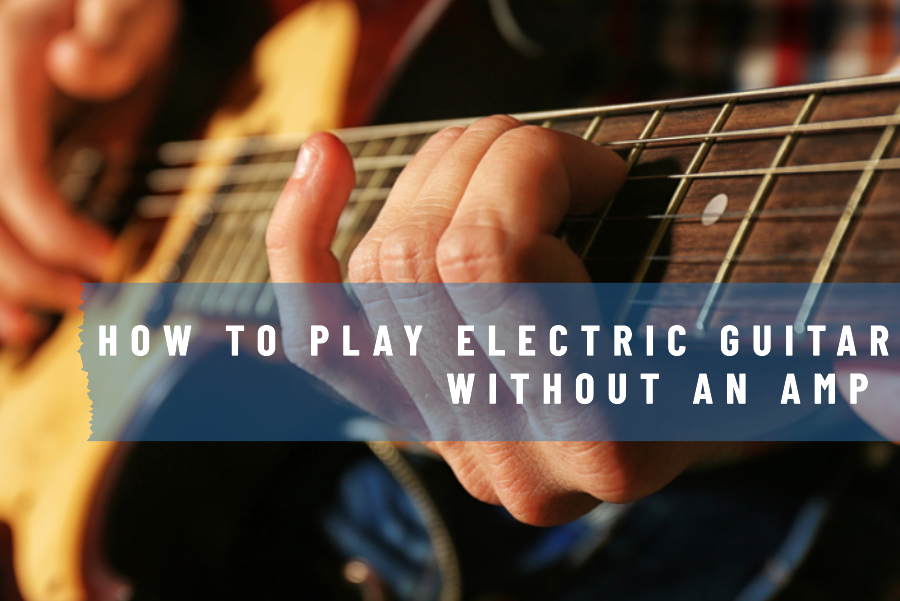
Ever found yourself wishing to lose yourself in your guitar’s melody, but the fear of disturbing your neighbors or lacking the space for an amp holds you back. Or simply don’t own an amp yet. Whatever the case, you’re probably looking for different ways to enjoy play electric guitar without an amp setup.
In this blog post, we’re diving into various creative and innovative ways to play your electric guitar amp-free. From using modern technology to tapping into simple, yet effective traditional methods, we’ve got you covered.
Can we play electric guitar without an amp ?
Absolutely! While it’s true that electric guitars are commonly connected with amplifiers to enhance their sound, they can indeed be played without one.
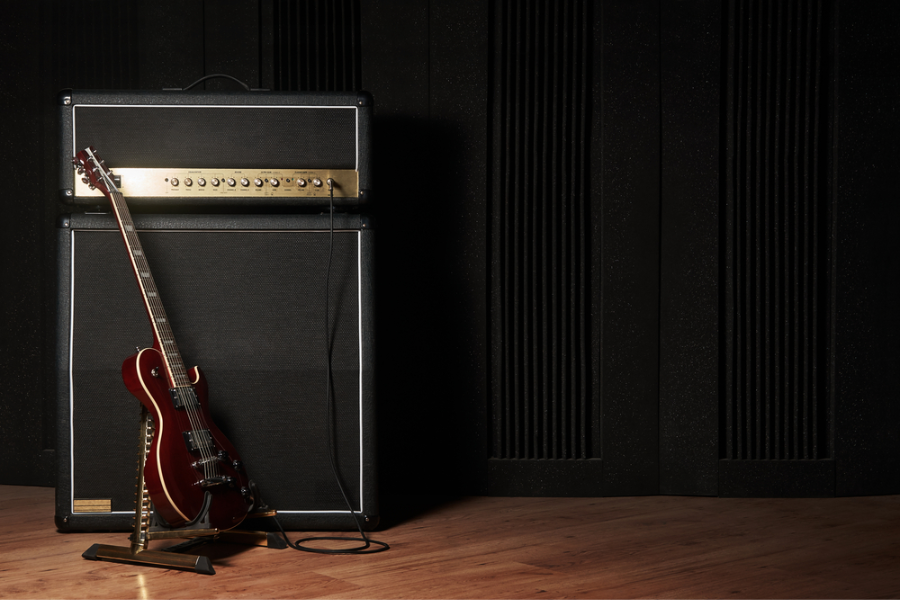
On its own, your electric guitar usually has very little sound and the signal thus needs to be amplified. It produces a sound in the range of 30-40 decibels. This means it’s pretty quiet when unplugged, but definitely not silent.
If you don’t want to disturb others or for when you’re just noodling around and getting a feel for the fretboard. This volume is perfect for you to practice sessions.
So it is possible for you to play electric guitar without an amp. You’ll be glad to know that there are many ways to enjoy your electric guitar amp-free. I will show you these methods below:
How to play electric guitar without an amp ? ( 6 Simple Ways )
Play Your Electric Guitar with a Mac or PC: A Simple Guide
Using your Mac or PC as an amp for your electric guitar is a fantastic way to explore new sounds and techniques. Most of us already have a Mac or PC, and with a simple setup, you can unlock a world of digital amps and effects. It’s perfect for quiet practice sessions, recording, or experimenting with different sounds.
To connect your electric guitar to your computer, you’ll need an audio interface. This device translates your guitar’s signal into a format your computer can work with. Audio interfaces are affordable and easy to use. It’s a small investment that opens up big possibilities.
Once connected, you can use software to simulate various amp sounds and effects. Tools like BIAS FX, Guitar Rig, Neural DSP, AmpliTube, and Line 6 Helix Native offer a vast range of sounds. Whether you’re into rock, jazz, or any other style, you’ll find tones to match your taste.
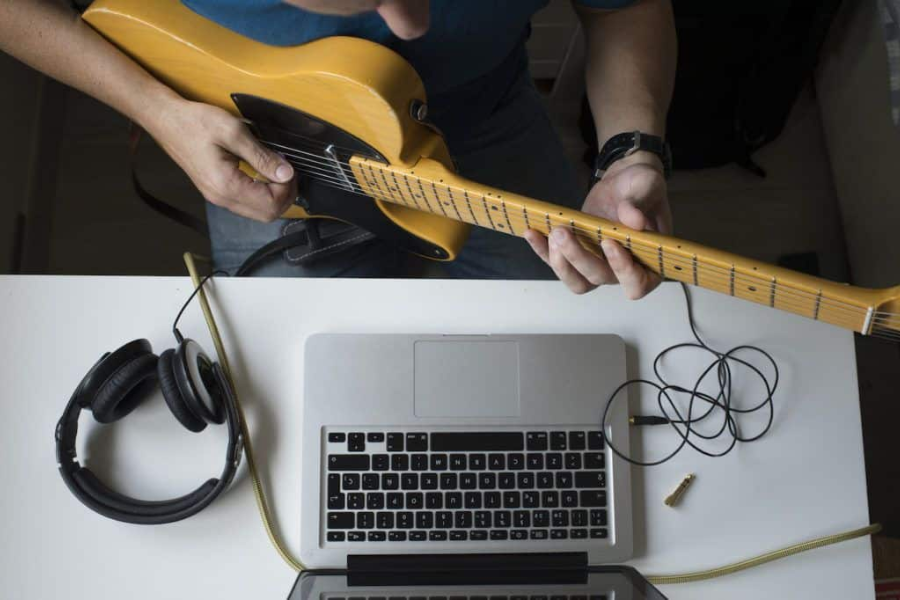
Using your Mac or PC as an amp for your electric guitar is a straightforward and exciting way. It helps you to expand your musical capabilities with a huge of advantages listed below:
- Versatility: Switch between different amp sounds and effects with a click.
- Convenience: Practice anytime without worrying about volume.
- Portability: Your laptop and guitar are all you need for a mobile setup.
Play Your Electric Guitar with Your iPhone and iPad
The number one reason is portability. With just your guitar and your iOS device, you can play anywhere, anytime. It’s perfect for those moments when inspiration strikes but dragging out an amp isn’t an option. Whether you’re traveling, hanging out in a park, or chilling in your room, your mobile device is your gateway to guitar greatness.
To connect your guitar to your iPhone or iPad, you’ll need an iRig. It’s affordable, small, and super easy to use. Just plug your guitar cable into the iRig, and then connect it to your device.
Once connected, a world of amp and effects apps awaits. Apps like AmpliTube, GarageBand, and Tonebridge give you a variety of sounds to play with. It provides from classic clean tones to wild effects. And you can tweak these sounds just like you would with physical pedals and amps.
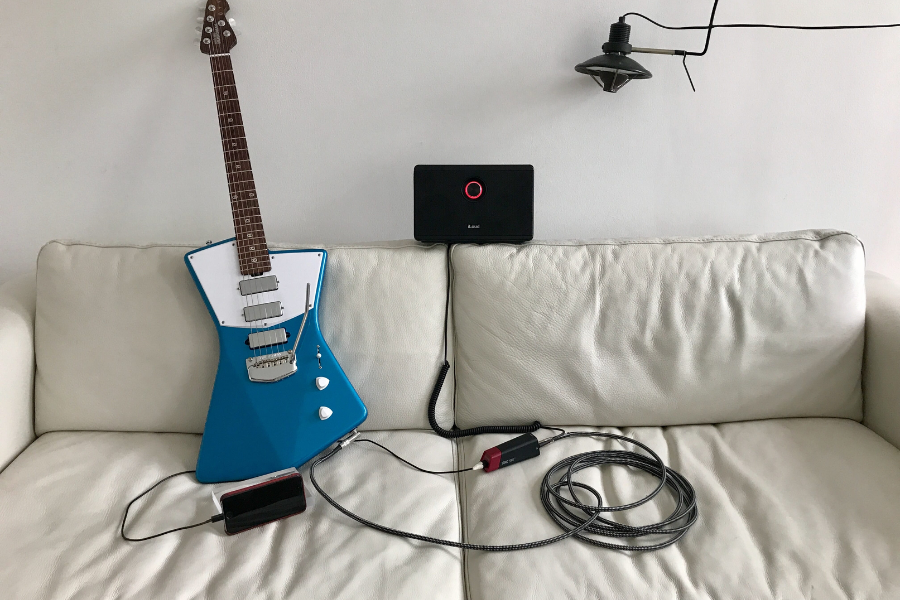
There are a lot of benefits from playing your electric guitar with an iPhone or Ipad you should consider:
- Flexibility: Switch sounds and effects with a tap. No more pedals and cables to manage.
- Convenience: Practice with headphones to keep things quiet. You also try plug into speakers to fill the room with your music.
- Creativity: Record your playing directly on your device. Layer tracks, try out different effects, and create your own unique sound.
What to keep in mind is that this setup is super convenient. However, the overall sound quality will depend on your headphones or speakers. Also, give yourself some time to explore and get comfortable with the apps.
Play Electric Guitar with Speakers and Studio Monitors
Using speakers or studio monitors is a practical and cost-effective method. This can be a more affordable option compared to high-end amps. They’re pretty good for playing at lower volumes. It is great if you’re trying to keep the peace with neighbors or family members. They offer clarity and detail that can help you fine-tune your sound, especially during recording sessions.
You’ll need an audio interface or an iRig to connect your guitar to the speakers. These devices convert your guitar’s signal to work with speakers or monitors. It’s a simple setup and super handy.
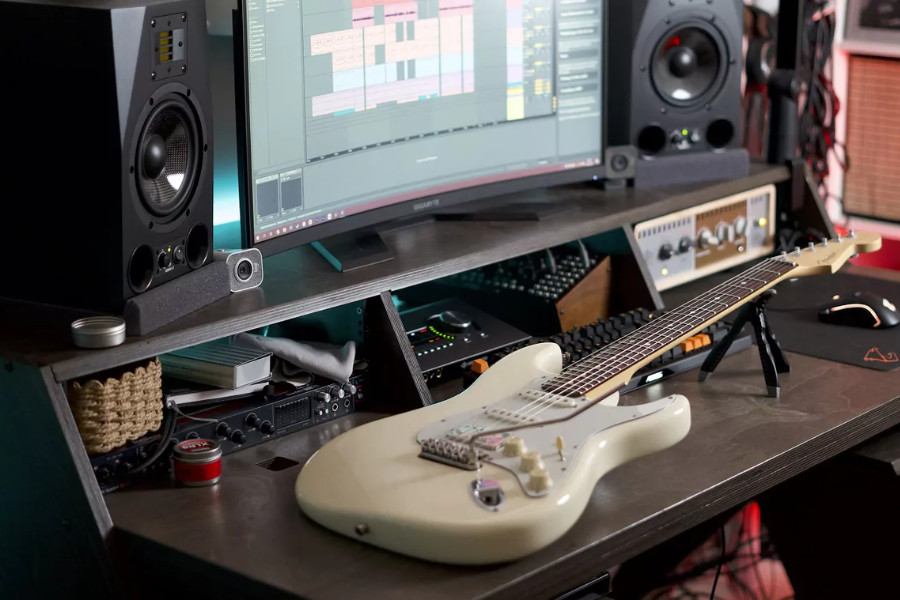
I’ve got a recommendation for you is the Focusrite Scarlett 2i2 . It is affordable and easy to use, perfect for beginners. It also comes with Pro Tools and Ableton Live Lite, offering many guitar plugins to explore.
What works for this way:
- Saves money: Cheaper than buying a new amp.
- Versatile: Suitable for playing and recording.
- Control over volume: Play quietly without losing quality.
However the sound might differ from a traditional amp, especially at higher volumes. You may also experience latency, but proper settings can minimize it. With the right audio interface, like the Focusrite Scarlett 2i2, you’re all set to enjoy playing and recording your guitar. Try it out for a new and exciting guitar experience.
Play Electric Guitar with Multi-Effects Pedals
Multi-effects pedals are versatile and can mimic an amp’s function. These send your guitar’s signal directly to a PA system, recording device, or even just your headphones. This makes them perfect for playing live, recording, or just practicing at home.
Setting up is straightforward. Connect your guitar to the multi-effects pedal. Then, link the pedal to your desired output. It can be it PA speakers, a studio desk, or just a pair of headphones for silent practice. Many of these pedals come equipped with a headphone jack. This makes it easy to play without disturbing others.
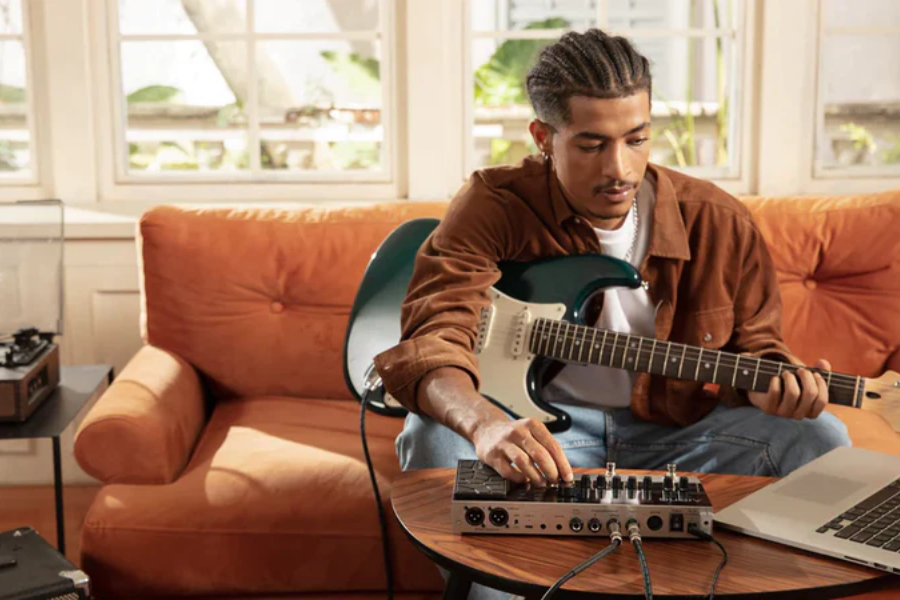
The Benefits
- Versatility: With a multi-effects pedal, you have access to countless amp models and effects in one compact device.
- Portability: It’s easier to carry around than an amp, especially if you’re playing gigs or traveling.
- Silent Practice: The headphone out feature lets you practice quietly, anytime and anywhere.
Multi-effects pedals offer a great alternative to traditional amps. However, they might not fully replicate the warmth and depth of an amp’s sound, especially at higher volumes. For many players, the convenience and range of sounds available outweigh this factor.
Playing Electric Guitar with Headphones
Getting your electric guitar to your headphones is pretty straightforward. You’ll need a little help from some cool gadgets like an audio interface, iRig, multi-effects pedal, or even a micro amp. Each of these has its own way of getting your guitar’s sound directly into your headphones.
- Audio Interface: This lets you connect your guitar to a computer. You can use digital amps and effects to shape your sound.
- iRig: Super compact and connects your guitar to a smartphone or tablet, turning it into an amp simulator.
- Multi-Effects Pedal: Plug your guitar in and use the headphone jack on the pedal to listen to your playing with effects.
- Micro Amp: These tiny amps often have a headphone output, perfect for silent practice.
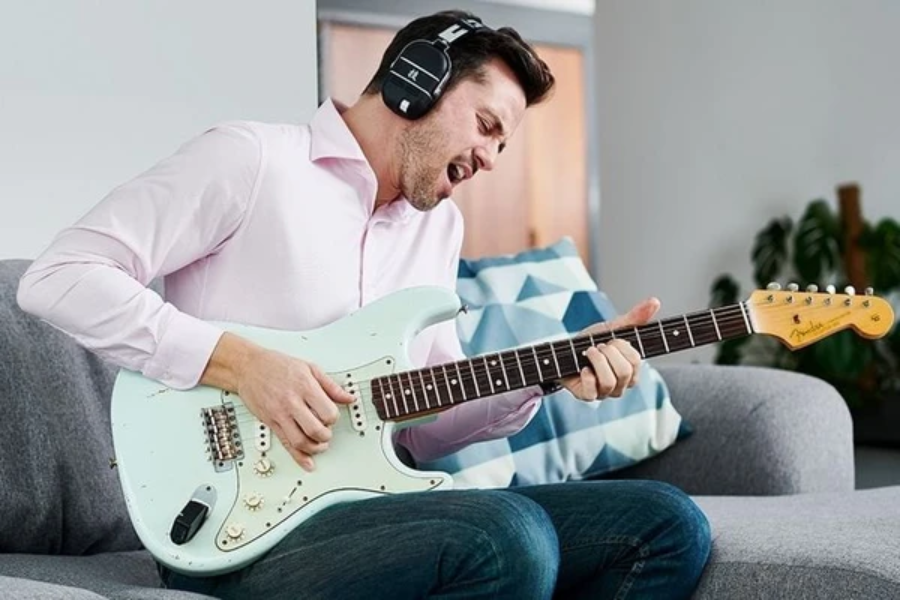
The Benefits
- No Distractions: It’s just you and your guitar. Perfect for focusing on your technique or getting lost in the music.
- Sound Exploration: With headphones, you can really hear the nuances in different effects and settings.
- Play Anytime: No more worrying about the time of day or who’s around. If you’ve got the urge to play, go for it.
Using headphones to play your electric guitar offers a mix of privacy, sound quality, and freedom to play whenever you want.
Playing Electric Guitar with Built-in Amps
Electric guitars with built-in amps could be just what you need. Perfect for those of us who value simplicity and mobility, these guitars let you play anywhere, from your living room to the great outdoors.
While they won’t replace your main amp in terms of power, guitars with built-in amps like the ElectroPhonic Model One and Pignose PGG-200 offer enough sound for practice and small gatherings. They’re especially appealing for beginners or as a secondary, travel-friendly option for experienced players.
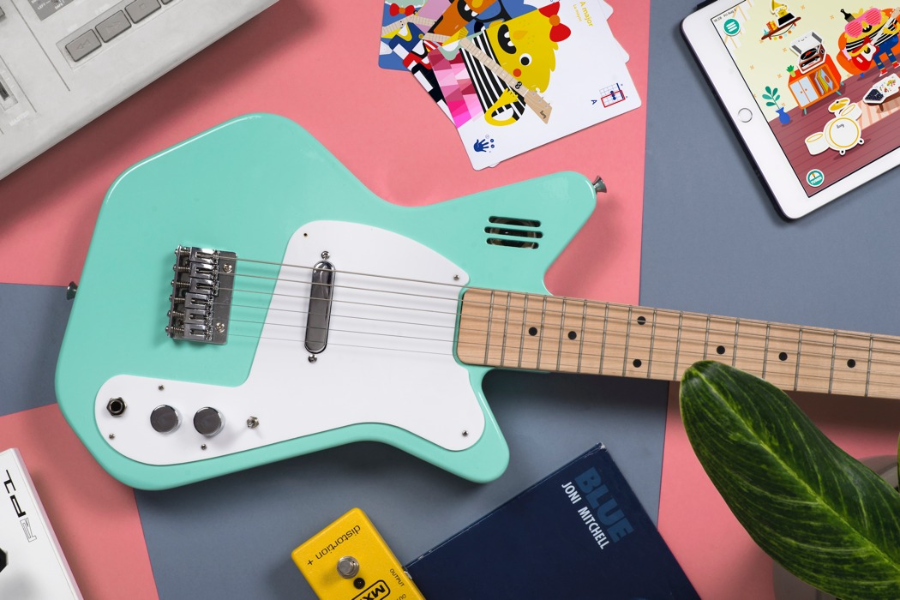
If you love playing electric guitar and crave the freedom to play anytime, anywhere, a guitar with a built-in amp is worth considering.
My final thoughts on how to play electric guitar without an amp
For me, the easiest and most versatile way to play electric guitar without an amp is by using a PC or Mac. All you need is a decent audio interface to connect your guitar to your computer.
Once set up, the world of amp simulation software opens up to you. I’ve had great experiences with free software like BIAS FX, which offers a wide range of tones and effects that can mimic the sound of a real amp quite convincingly. Recording your playing becomes a piece of cake.
If portability is your main concern, then using an iPhone or iPad can be a game-changer. Similar to the PC or Mac setup, you’ll need an audio interface designed for iOS devices. I’ve used my iPhone for practice sessions while traveling, and it’s fantastic.
You can plug in your headphones and jam out without disturbing anyone. Apps like GarageBand come loaded with a variety of amp models and effects, making it easy to find your sound on the go.
Your playing style doesn’t have to be limited by not having an amp. Whether you’re at home, traveling, or on a budget, there’s a solution that fits your needs. Try out these options and keep the music flowing!

